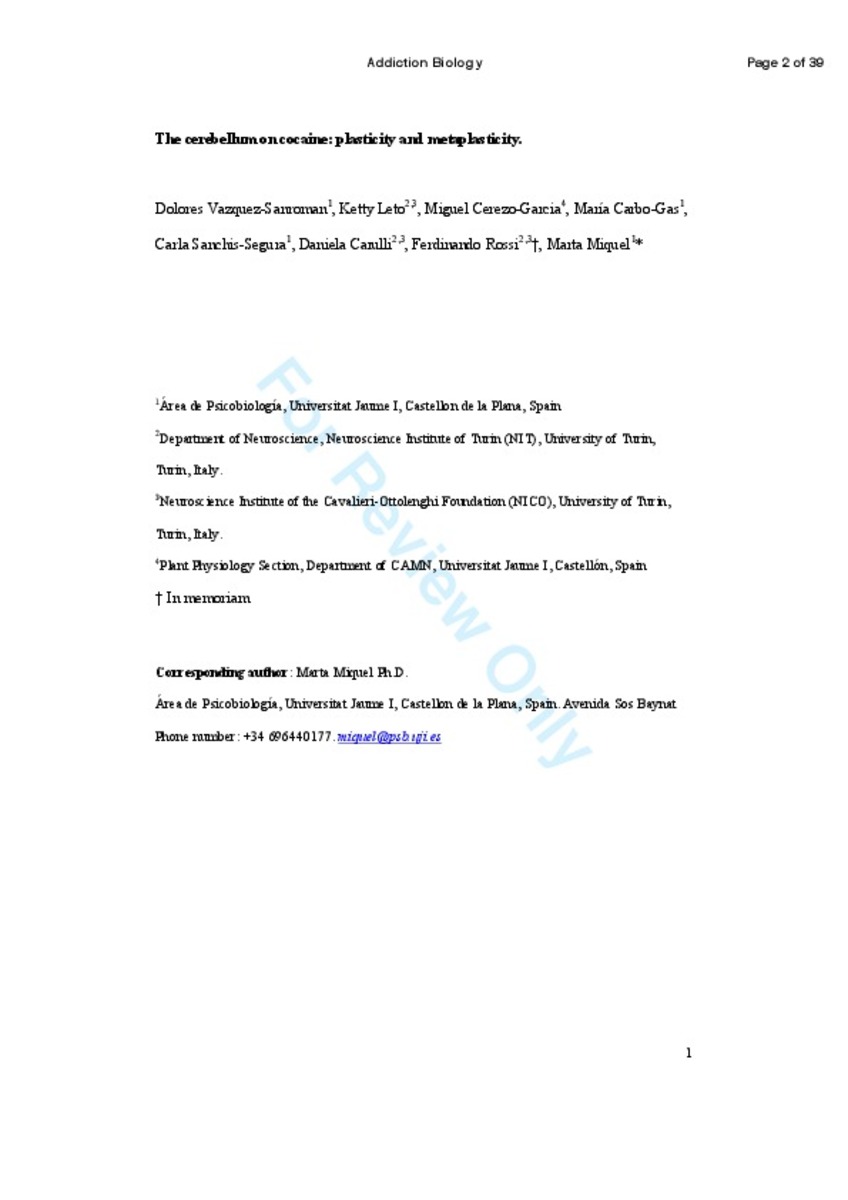Mostrar el registro sencillo del ítem
The cerebellum on cocaine: plasticity and metaplasticity
| dc.contributor.author | Vázquez Sanromán, Dolores | |
| dc.contributor.author | Leto, Ketty | |
| dc.contributor.author | Cerezo García, Miguel | |
| dc.contributor.author | Carbó Gas, María | |
| dc.contributor.author | Sanchis-Segura, Carla | |
| dc.contributor.author | Carulli, Daniela | |
| dc.contributor.author | Rossi, Ferdinando | |
| dc.contributor.author | MIQUEL, MARTA | |
| dc.date.accessioned | 2016-02-18T10:23:36Z | |
| dc.date.available | 2016-02-18T10:23:36Z | |
| dc.date.issued | 2015-09 | |
| dc.identifier.citation | VÁZQUEZ SANROMÁN, Dolores; LETO, Ketty; CEREZO GARCÍA, Miguel; CARBÓ GAS, María; SANCHIS SEGURA, C.; CARULLI, Daniela; MIQUEL SALGADO-ARAUJO, Marta. The cerebellum on cocaine: plasticity and metaplasticity. Addiction Biology (2015), v. 20, n. 5, pp 941–955 | ca_CA |
| dc.identifier.uri | http://hdl.handle.net/10234/150527 | |
| dc.description.abstract | Despite the fact that several data have supported the involvement of the cerebellum in the functional alterations observed after prolonged cocaine use, this brain structure has been traditionally ignored and excluded from the circuitry affected by addictive drugs. In the present study, we investigated the effects of a chronic cocaine treatment on molecular and structural plasticity in the cerebellum, including BDNF, D3 dopamine receptors, ΔFosB, the Glu2 AMPA receptor subunit, structural modifications in Purkinje neurons and, finally, the evaluation of perineuronal nets (PNNs) in the projection neurons of the medial nucleus, the output of the cerebellar vermis. In the current experimental conditions in which repeated cocaine treatment was followed by a 1-week withdrawal period and a new cocaine challenge, our results showed that cocaine induced a large increase in cerebellar proBDNF levels and its expression in Purkinje neurons, with the mature BDNF expression remaining unchanged. Together with this, cocaine-treated mice exhibited a substantial enhancement of D3 receptor levels. Both ΔFosB and AMPA receptor Glu2 subunit expressions were enhanced in cocaine-treated animals. Significant pruning in Purkinje dendrite arborization and reduction in the size and density of Purkinje boutons contacting deep cerebellar projection neurons accompanied cocaine-dependent increase in proBDNF. Cocaine-associated effects point to the inhibitory Purkinje function impairment, as was evidenced by lower activity in these cells. Moreover, the probability of any remodelling in Purkinje synapses appears to be decreased due to an upregulation of extracellular matrix components in the PNNs surrounding the medial nuclear neurons. | ca_CA |
| dc.description.sponsorShip | Ministerio de Economía y Competitividad (PSI2011- 29181); FPI-PREDOC2009/05; FPU12/04059; PPF 2013 ((13I087.01/1) | ca_CA |
| dc.format.extent | 39 p. | ca_CA |
| dc.format.mimetype | application/pdf | ca_CA |
| dc.language.iso | eng | ca_CA |
| dc.publisher | Wiley | ca_CA |
| dc.relation.isPartOf | Addiction Biology (2015), v. 20, n. 5 | ca_CA |
| dc.rights.uri | http://rightsstatements.org/vocab/CNE/1.0/ | * |
| dc.subject | BDNF | ca_CA |
| dc.subject | Cerebellum | ca_CA |
| dc.subject | Cocaine | ca_CA |
| dc.subject | Mice | ca_CA |
| dc.subject | Sensitization | ca_CA |
| dc.subject | ΔFosB | ca_CA |
| dc.title | The cerebellum on cocaine: plasticity and metaplasticity | ca_CA |
| dc.type | info:eu-repo/semantics/article | ca_CA |
| dc.identifier.doi | http://dx.doi.org/10.1111/adb.12223 | |
| dc.rights.accessRights | info:eu-repo/semantics/openAccess | ca_CA |
| dc.relation.publisherVersion | http://onlinelibrary.wiley.com/doi/10.1111/adb.12223/abstract | ca_CA |
| dc.edition | Postprint | ca_CA |
| dc.type.version | info:eu-repo/semantics/acceptedVersion | ca_CA |
Ficheros en el ítem
Este ítem aparece en la(s) siguiente(s) colección(ones)
-
PSB_Articles [1294]
Articles de publicacions periòdiques -
CAMN_Articles [566]







